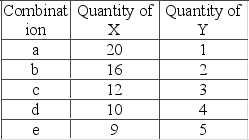Multiple Choice
The table shows an indifference schedule for several combinations of X and Y.  In moving from combination a to b, then to c, d, and e, the marginal rate of substitution of X for Y
In moving from combination a to b, then to c, d, and e, the marginal rate of substitution of X for Y
A) increases.
B) decreases.
C) stays the same.
D) decreases and then increases.
Correct Answer:

Verified
Correct Answer:
Verified
Q67: Refer to the diagram, where xy is
Q69: Suppose that MUx/P<sub>x</sub><sub> </sub>exceeds MUy/P<sub>y</sub>. To maximize
Q70: Indifference curve analysis<br>A) presumes, as does utility
Q77: Health insurance often pays 80 percent of
Q153: If a consumer is initially in equilibrium,
Q221: If a product has a diminishing, but
Q228: The reason the substitution effect works to
Q247: If marginal utility is diminishing, total utility
Q328: Utility refers to the<br>A)satisfaction that a consumer
Q339: Indifference curves are linear, and budget lines